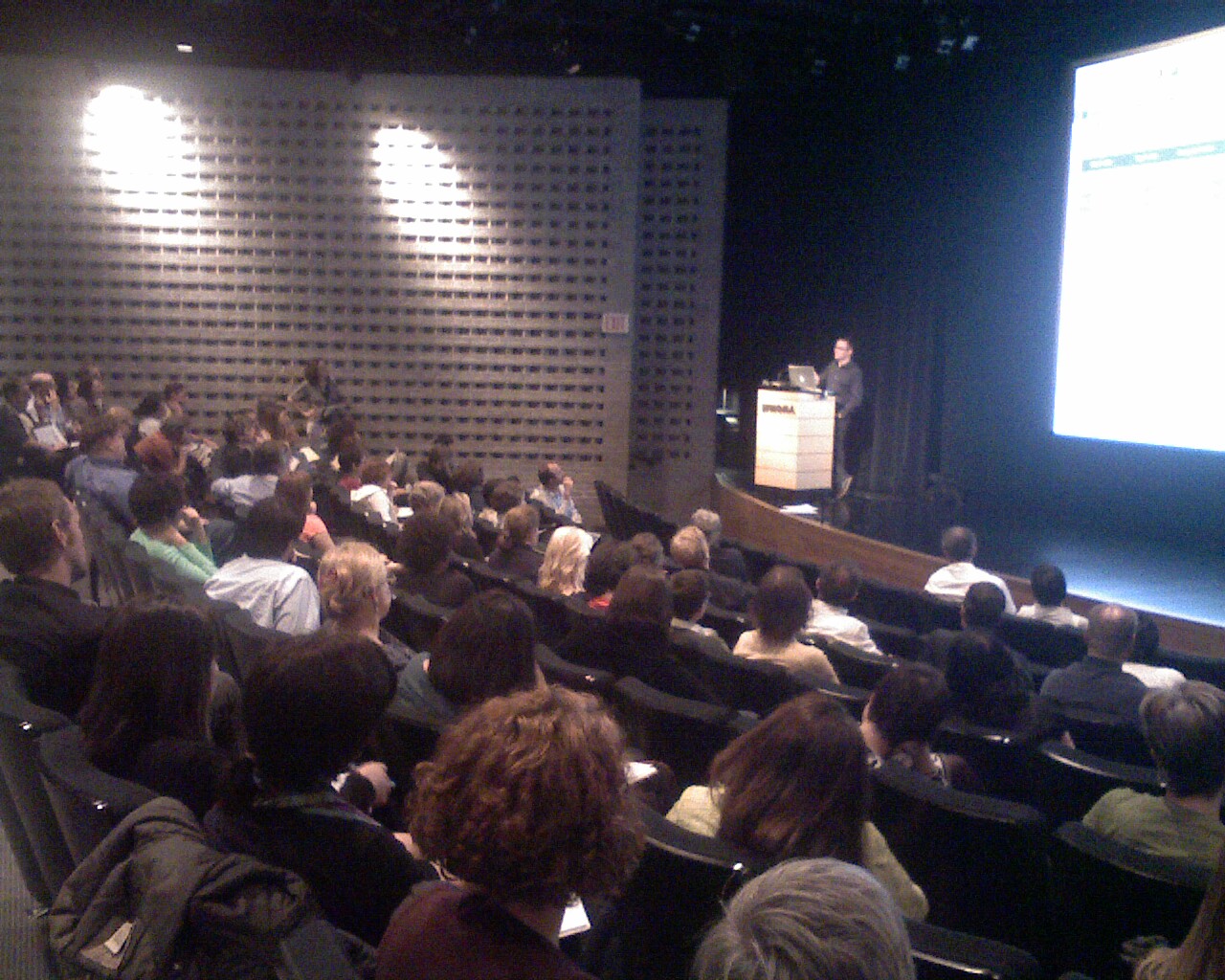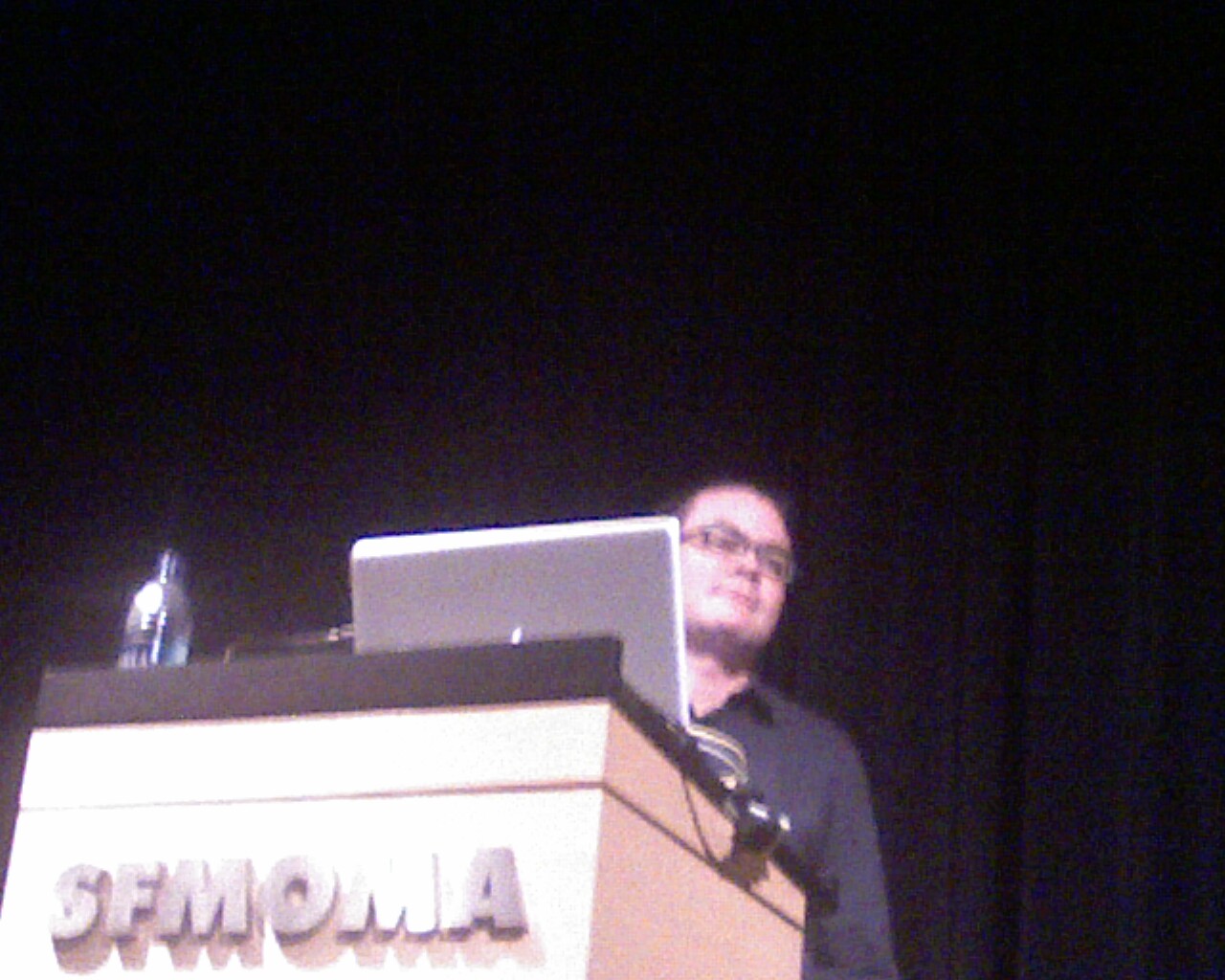By Susan Spero

Susan Spero
As I sit with my cup of coffee this morning and think through yesterday’s tour de force by Seb Chan, I too realize that like a tweet on #sfmetrix stating that a tornado of ideas was spinning through the tweeter’s mind, mine too feels like it has been hit by a storm.
Tremendous kudos are in order for the organizers for sponsoring a great day: the National Arts Marketing Project, Theatre Bay Area, American Express, The San Francisco Foundation, the Wallace Foundation, SFMOMA, AAM Museum and Technology, Museum Computer Network, WMA, along with other organizations and certain individuals.
The star of the day was Seb Chan who literally held the podium for the entire day showing how the team at Powerhouse Museum (http://www.powerhousemuseum.com/) have, through time, built a smart online system.
Their considered online philosophy and care has given them results: the Powerhouse collection has been pushed to the forefront of their visitor’s online experience. A larger percentage of visitors spend time on pages that have to do with the collection more than with any other offerings. Their visitors engage and use the collections information available: from the fabric swatches for creating a new issue of the designs or even as insights into objects for an ebay transaction (buying or selling, who knows). The Powerhouses’s willingness to share incomplete material from their collections data base has even triggered new knowledge about the collection based on interested visitors sharing what they know.
 Seb walked us through the choices their producers and in-house developers make as they consider open options for looking at the collection. Simple things like visitor language tags, and statements of significance as to why and object is important help make the objects relevant for an online visitor (scroll down on the link and browse through these amazing book dresses).
Seb walked us through the choices their producers and in-house developers make as they consider open options for looking at the collection. Simple things like visitor language tags, and statements of significance as to why and object is important help make the objects relevant for an online visitor (scroll down on the link and browse through these amazing book dresses).
Over and over Seb implied that the Powerhouse philosophy is to listen, learn and seek ways to understand how their audience uses and/or wants to use their collection. The team constantly wonders: What is the relevance of the collection and how can digital tools let us serve that need?
Go to where the audience is already living, is a key phrase for those who promote social software, and the Powerhouse museum understood this idea from the get-go. They were the first museum on the Flickr Commons, and by putting their Tyrell Collection of historic photographs of Sydney on board early, they increased awareness of the Powerhouse museum with the community that cares about photography. What intrigued me is that this intense audience-interest in photography online has had an impact on the curatorial choices the Powerhouse Museum is making; they are going to (or have) hired a curator that can support the photographic collection.
Additionally, Seb noted that, at least in his mind, curators now and in the future need the skill sets to be able to work in the digital realm. In fact as part of their official curatorial responsibilities all Powerhouse curators blog. The web is a communication platform and everyone on staff needs to know how to use it to help audiences connect with museum resources.
The afternoon session was a geek’s dream in that it focused on the many metric systems that can be used to analyze just who uses your website and how they use it. What was most telling though was how Seb admitted up front that many of the numbers tell you nothing when thrown out as just numbers.

Seb Chan, Head of Digital, Social & Emerging Technologies, Powerhouse Museum at the podium at SFMOMA
The key, as with all statistics, is that you know how to read them so they can influence future actions. Find patterns over time. So, for example, is there an upward trend when you open an exhibition or open up registrations for summer camps? Is there a downward trend on holidays (usually, weekends are evidently down for all internet users: guess what we read while we are at work). And look at how others in your area are doing: if a competing institution has a sudden spike in their numbers and yours are flat, can you figure out why and how that happens.
You want to know how many people touched your content. Let the analytics help you understand this. If not already known, concepts like dwell time, bounce rate, and ISP logs are now a part of the mindset of every listener in the Friday’s room . Dwell time measures how long visitors stay at your site, but even then those numbers have issues since you can only measure how long someone was at the second to last page they were on while visiting your site as there is no way (yet?) to account for how long a person is on the last landed page of a session. So you could discover that the average time spent on your site is four minutes, but who knows what amount of time passed when visitors finally found that great educational video you produced. Bounce rate is how quickly someone is in or out of your site; you want bounce rate to be low on education pages, but high if you are buying tickets for an event (get in and get the sale done quickly).
And ISP logs help you gain a finer grain view of your visitors, although the privacy invasion is real and alive on the web; you can be tracked for where you’ve been browsing, and while I have always understood this, Seb’s reminder made me pause.
One of the most solid pieces of advice Seb offered is for institutions to use freeware for online analytics, but PAY someone to help you customize your specific number crunching. You need to understand what the numbers mean, and HOW they will impact your future behavior The twitter #sfmetrix site notes that there were tons of free “Kewl Tools” out there for the using (search twitter for #sfmetrix and you can read through the tweets of the day).
There were many big take-away thoughts:
1. Beta Test: Don’t hesitate to beta test your site putting it online sooner than later: it doesn’t have to be finished before you go live. In fact some of the things you learn that are most valuable are when you go live and real visitors are using it. Seb thinks we should also try to work the same beta testing for some exhibition efforts.
2. Be Adept Enough to be Relevant: Web thinking, with its open, speed driven approach needs to work backwards into how our institutions function. Remember the photography curator story developing from increased interest built in Flickr commons.
3. And finally: Note to self. Scour the Powerhouse’s web site. I mean really look at it very carefully. There is much to learn about collections access and smart web design.
Lastly, Seb has a blog that presents many of the ideas and projects seen yesterday: it is a great resource.
Others of you were there. What are some of your biggest take-aways? And those of you who were not, any thoughts on collections access or museum metrics? Great examples or challenges in practice?








Comments
Seb, thanks for being not only a virtual mentor and museum saint, but now a guardian, guide and mediator of the exchange in this space -- THANK YOU!
Margaret, API is an important component of the work at-hand = Application Program Interface http://en.wikipedia.org/wiki/Application_programming_interface; an important example is Google Map's http://code.google.com/apis/maps/.
It's an important aspect of software development and not always "open." And, in this case, it's the "tool" by which programmers sign-up and become volunteer collaborators -- like in the creation of those cool maps of Sydney Seb showcased created by an "audience" member to enhance Powerhouse offerings.
Who knew people would program for "free"? A whole new standard of engagement for metrics and evaluation, right?
Thanks Michael, I went in and fixed it. What was your big take-away? Curious minds.....
Great post! I love that the Powerhouse Curators blog!
Susan,
Thanks for your thoughtful post which framed many of the remarkable tools that Seb Chan demonstrated and explained to all of us who were lucky to be in the audience. Like you, I was intrigued by the potential interface between Google mapping, historic photos from the Powerhouse's collections, and Flickr ... and the new insight these kinds of mashups can bring to public understanding of local places and their buried histories.
I also agree wholeheartedly with Seb's assertion about curators (and by extension *all* museum professionals) needing to be more willing to use the potential of Web 2.0 to engage people in content.
I was less convinced about the use of metrics, esp. measuring the impact of a blog post by the number of hits, comments, "klaut," "re-tweets" and other tools discussed. Surely we will come up with more sophisticated measures than these? Why use old ideas to measure the impact of such a new form of cross-communication?
Dwell time, for example, is a slippery concept, as is hits. My 9 year old nephew is a master of generating hits to his blog posts -- does that make his content about the planets he's seen more robust than, say, a scientist who has studied astonomy her whole life?
Thanks again to everyone for all of your work in this arena, especially Seb Chan!
Ah yes, the numbers and what to do about them. I was most intrigued when Seb indicated that the Powerhouse team uses the data to figure out where visitors go to the site, and what it is that they are looking for when they get there. When he demonstrated the data indicating which lesson plans are most popular for their local community I realized that the numbers could be quite useful. Finding someone who knows how to frame the numbers for your needs is key. Use the free tools but pull in a professional to help you set them up in a way that tells you something about what to do next.
We are still mucking around with all of this, but we will find a way to use these tools to teach us about visitor engagement.
You are right though, you've got to realize just how slippery these numbers are.
Thanks for commenting!
Thanks!
My main point with the metrics stuff is really to figure out what you are trying to measure and why and what you are going to do with the results BEFORE you start choosing your tools.
@marjorie: you are completely correct about dwell time - it is a poor metric if used without a purpose. We use it sparingly and in conjunction with other measures in evaluating whether a page is well designed in terms of leading a visitor through a process such as buying a ticket or booking an event or finding out where we are etc.
As was tweeted out, I write a long paper on all the metrics stuff for MW08 which you can read online at http://www.archimuse.com/mw2008/papers/chan-metrics/chan-metrics.html
All these tools can be useful in helping you understand different facets of behaviour on your site currently. None of them tell you whether someone enjoyed it or not though - that takes qualitative surveying.
Susan,
I was so bummed to have missed Seb's talk. Thank you for the terrific write-up. I'm sure many others are in my shoes and quite grateful!
Best,
Maria
Seb's talk changed the entire way I think about online museums. And online communities. The things he did and said will affect my thoughts and actions in so many spaces: The work I'm doing with The Tech Museum Virtual, CRM, Service Leadership, online metrics, video and television.
Seb - Thank you for the courage and persistence it took to get this far and keep up the great pioneering work!
PS thanks for the link to the metrics paper, its great.
I too attended the Sebastian Chang PowerHouse museum symposium. I would just like to say, that you for this resource. And I would also like to point out the the link you have to Sebastians blog is incorrect.
Thank you for the great talk Sebastian and Powerhouse, and all the sponsors.
Thanks Seb for the link. Very useful. Hope you are having time to enjoy California before you head back down under. Marjorie
Still mulling over so many ideas from Friday. One that sticks with me especially is Seb saying that as museums we should not try to substitute for social media or social spaces online. "Focus on what you do best," and "go where your audience is." What a great idea to keep the lengthy discussions on flickr and pluck the data you want to include rather than putting up each and every comment on your site. It's certainly more labor intensive, but as museums we are all about the quality of our collections and our presentations.
What an inspiring day!
Susan asked for a few big take-away thoughts from the day. As a person who focuses on the importance of connections between museums and their communities, I noted several interesting ways that Seb’s presentation made sense:
--The Design Hub (D*Hub) links to events at other organizations, and it links those other events to the Powerhouse Museum's collections. Great collaboration and connections!
--Think about how you can take the content of your exhibitions and collections outside the museum, such as creating street tours, lists of other sites related to the content, etc. This connects the museum with its local community.
--Having a "No Photography" policy stifles people blogging about your museum and sharing their photos via Flickr, etc. Your museum may want to re-think its photography policy.
--Think about what you can learn about your museum by monitoring blog entries about your museum. What is the public perception of and public experience with your museum? How can you effectively analyze this information and use it to enhance the visitor experience at your museum?
--I loved the "Statement of Significance" on the on-line collections entry! That warmed my heart.
--Think about the following: "How can a curatorial blog build opportunities for through-the-door visitation?" The on-line presence (including blogs) can showcase opportunities and programs at the museums, increasing visibility, visitation, and engagement.
Those are some of the thoughts I had during the day. The discussion about metrics was good. Seb focused on thinking about what you want to know, why you want to know it, and what you will do with the information before you really start in on measuring. That will drive your whole evaluation process, and it is strategic and effective. The technical discussions were hard for me to follow, since I am not technically familiar with the lingo (was it API? IPI? APR?), but I did write it down and will go to the sites and explore. I am an evaluator, and so I do think about how information is to be used.
Oh, I've had a few questions in various channels about the 'statement of significance'. In other countries this is sometimes known as provenance.
The Collections Council of Australia has just released a guide, aimed primarily at small museums, on implementing good provenance documentation as part of an overall collections strategy. It is well worth a read - Significance 2.0 : http://significance.collectionscouncil.com.au/
Thanks so much for this very interesting workshop. It was great to get such great perspectives from both collections-based museums and performing arts organizations.
I have a question for Seb Chan. I seem to recall a mention of Word Press phasing out the Single User install and only supporting the Multi-user version. Did I hear this correctly? I can't seem to find more detail on the web. I sure hope WP is doing something to give them more time to focus on making the multi-user version more stable.
Thanks again!
@james . . . on the API front, making an API available does NOT mean people will actually do anything useful with it. Nor does it mean that you will like what they do do.
Again, I'd argue that none of our sites get enough traffic to warrant an API unless we have strong ties to a developer community who will actually do something useful with it.
Our work simply leverages the pre-existing Flickr API.
Thanks everyone for organizing and running this event, and for keeping it aloft & extending it. Big lasting impact at a key moment. If you hadn't done this when you did i'd be screwed by my own ignorance!
Add new comment